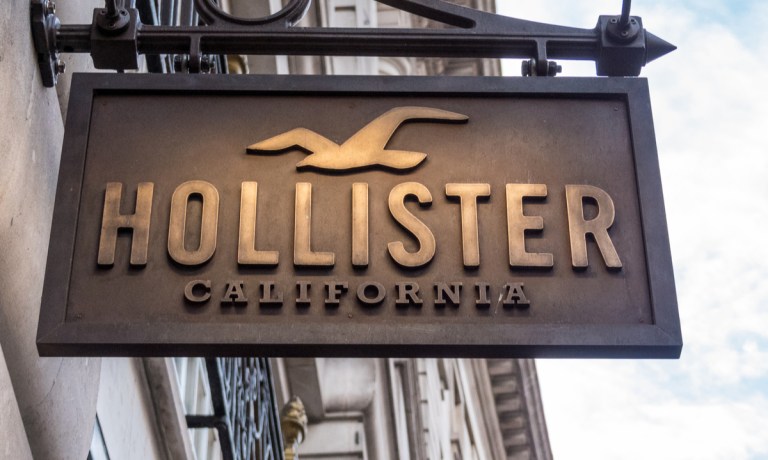Hollister Overhauls to Tap Impulse Buying Opportunity

Opinions may vary, but Hollister Co. has left a lasting impression on those who came of age in the early 2000s. Renowned for its beach-inspired ambiance, low lighting, and captivating fragrance that hovered between inviting and overwhelming, the brand offered a memorable shopping experience.
However, Hollister, along with its sister brand Gilly Hicks, is now embarking on a new venture, unveiling a new store concept side by side at the Liverpool One shopping complex, in hopes of converting browsing customers into paying customers.
The venture follows its announcement in February which revealed they would be joining forced under one roof.
Encompassing 7,300 square feet, the store embraces a revitalized brand identity tailored to meet the preferences of the teenage consumer base shared by Hollister and Gilly Hicks.
Inside the store, customers can explore a selection of clothing for men and women from Hollister and Gilly Hicks. Additionally, Gilly Hicks will offer its activewear and loungewear collections.
The store will showcase the brands’ omnichannel offerings, including a click-and-collect zone. Customers can also place orders in-store for same-day delivery.
In a statement, Abercrombie & Fitch aid this store serves as the prototype for the brands in Europe.
Abercrombie’s Success in Revamps
The move follows Abercrombie, the parent company of Hollister and Gilly Hicks, successfully reevaluating and transforming its brand image, moving away from its provocative advertising campaigns.
Abercrombie’s endeavors have yielded positive results, as evidenced by its announcement on May 24 that it exceeded analysts’ projections by reporting an unexpected profit and raising its outlook for the entire year.
“Abercrombie’s offering is resonating meaningfully with our target customer, setting several other sales records this quarter across genders, categories and geographies,” Chief Executive Officer Fran Horowitz said at the time of the earnings call.
However, Hollister sales fell 6.7% year over year.
Read more: Abercrombie Transforms Controversy Into Profits
Brands Flock to Retail Concepts
While striving for a $4 billion valuation for Skims, Kim Kardashian is preparing to launch the brand’s first permanent stores in the upcoming year, as a strategic move to expand into both domestic and international retail markets.
Scheduled for the first half of 2024, Skims’ flagship store in Los Angeles will be followed by another location in New York. Situated on Sunset Boulevard in West Hollywood, the boutique will occupy a 5,000 square feet near streetwear destinations like Supreme and Kith.
“Kim and I can envision a future where years from today there’s a Skims store anywhere in the world you’d find an Apple store or a Nike store,” said Jens Grede, co-founder and chief executive officer of Skims. “It marks the second chapter.”
See also: Skims Plans Global Expansion With Inaugural Flagship Stores Amid Retail Challenges
Then there’s Chanel, who has signed one of the largest lease agreements since the onset of the pandemic, in the shopping district of Causeway Bay in Hong Kong.
The decision to lease in Hong Kong coincides with the relaxation of travel restrictions earlier this year, resulting in a resurgence in tourism for the city. According to the Hong Kong Tourism Board, visitor numbers have soared from under a million in January to nearly 3 million in April.
Read more: China Seeks Spike in Travel and Shopping Following Pandemic
In conjunction with the increase in visitor numbers, rental prices in Causeway Bay fell due to protests and the pandemic. As a result, Chanel is expected to pay lower rent compared to previous tenants. According to Colliers International, rental rates in Causeway Bay as of March were only 30% of the peak levels observed a decade ago.
The luxury label has experienced a slowdown in sales in the U.S. The Financial Times (FT) reported in late May that Chanel, following approximately 10% growth in 2022, has now shifted to single digits for the current year.
“We had a softening in the U.S., so no different from some of our competitors, from November of 2022, and that’s continued over the first few months of 2023,” Chanel Global Chief Financial Officer Philippe Blondiaux told the FT.
Read also: Chanel Signs Largest Retail Lease Agreement Since the Pandemic in Hong Kong
Brands Flocking to Retail for Impulse Buying
In an effort to entice consumers to not only browse but make purchases, brands and retailers are embracing retail concepts that offer immersive and personalized experiences. This investment stems from the understanding that retail has become a breeding ground for impulse buying, as highlighted by PYMNTS.
Consumers display an array of purchasing behaviors, according to the report. For instance, one person with limited money management skills might enter a store and accumulate credit card debt impulsively, without much consideration. On the other hand, another consumer might perceive the in-store experience as an opportunity to physically interact with a product, gather information, and seek clarification before making a carefully thought-out purchase decision.
While it is indeed true that both types of buyers exist, even the most thoughtful purchaser has the potential for impulse buying. When a consumer enters a store, it signifies a level of purpose or interest in the products on sale.
The in-store experience has the potential to trigger impulsive purchases due to the presence of products that engage customers’ senses.
This concept is exemplified by Kohl’s, as reported by PYMNTS in May. Despite a nearly 20% decrease in digital sales during Q1 2023, Kohl’s in-store performance improved, largely due to its collaborative shop-in-shop partnership with Sephora.
Read more: Kohl’s Digital Sales Drop Nearly 20% in Q1 as Sephora Helps Improve In-Store Results